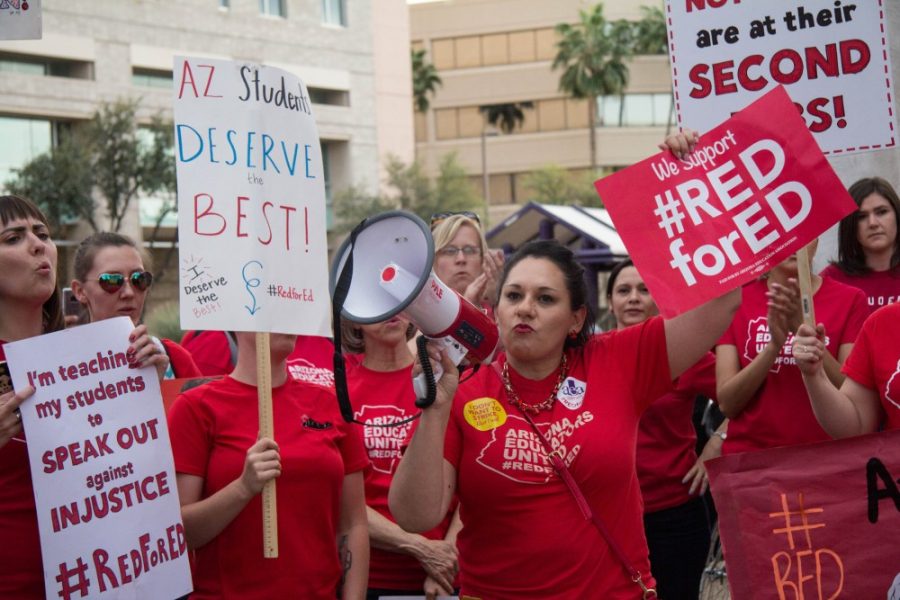In the wake of national strikes, protests, walkouts, political infighting and various divisive issues demanding direct action, Arizona is becoming the next battleground state for education and gun control activists.
This past year alone has seen teachers’ walkouts and strikes in three other states — Kentucky, Oklahoma and West Virginia — and gun control protests all across the country in response to a year that the Gun Violence Archive reports has already suffered nearly 5,000 deaths in incidents involving firearms.
In fellow red states Kentucky, Oklahoma and West Virginia, Arizona teachers saw a game plan.
In West Virginia, teachers gained the upper hand by striking and walking out all at once, forcing a response from the State Legislature before the political pressures could start acting fast enough to break up the teacher’s union.
After West Virginia surprised the rest of the country by getting concessions from the state government, teachers in Oklahoma and Kentucky started organizing to fight against cuts to their pension and continually low investment in their classrooms.
According to Bloomberg, these teachers are “reviving the tactics of an earlier era,” a reference to the direct union action that has been falling behind in the past several decades.
But what needs to be asked, now that direct action is returning and public protests over national issues continue to divide or bring us together, is whether or not this all works.
To answer this question, The Washington Post looked at the data from counties who either did or did not experience civil rights protests during the 1960s and ‘70s, in an attempt to judge whether mass-scale protests actually change public opinion in either the short or long term, and they found the evidence pretty convincing.
The Post reported counties that participated in mass protests had “2.5 percent more likelihood of supporting affirmative action [and] 3 percent more likelihood of identifying with the Democratic Party today,” which means that, even 50 years down the road from the locations of mass protests, the effects are still being felt.
However, whenever we turn on the news, it is easy to find just as many people turned away from issues by protesters as there are people actually marching.
Are these protests just dividing us up even further, and therefore, we’re just shooting ourselves in the foot by making each issue a divisive point that pushes all but the most radical away?
A Harvard study on this topic explained that the most important aspect of a protest was not just attracting attention or scaring public policy leaders, it’s getting people invested in the issue, which has to be done in the right way to keep the middle ground on board.
By attracting the public eye and inspiring people to have an opinion and act on a certain goal, it not only signals to politicians that this issue is a sticking point to a sizable voting block, it also shows them that their zeal on the subject will keep protest attendees energetic and politically active down the road.
But not all protests are able to inspire concessions; The Atlantic wrote on the important distinction between violent and nonviolent protests, clearly explaining why nonviolence is not only the best answer, it is almost always the only answer.
The Rotman School of Management published a study that showed that when liberals were given reports of anti-Trump protesters acting violently and erratically, they actually reported supporting Trump more than they did before the test was begun.
Furthermore, The Atlantic wrote that when more moderate or undecided passerbys witnessed radical and violent actions by protesters, they just can’t empathize enough to listen to their message.
The study found the exact opposite for non-violent protesters, where people were more likely to report supporting causes when they heard news reports of those leading the marches responding to violence with non-violent means.
All of this shows that not only are marches, protests and walkouts potentially a unifying and powerful move by teachers and students to accomplish political goals they find near and dear to their hearts, it is also capable of pushing those ready to lend support away if it drifts towards radicalization and violence.
It is important for every cause to not only remember their own cause, but to never forget those watching them, ready and willing to give support, if only they remain a peaceful in response to tyranny and mismanagement.
Alec Scott is a Sophomore studying Political Science and German Studies who volunteered for the 2014 Ron Barber Congressional Campaign. Follow Daily Wildcat on Twitter.









